最新中学中考英语语法专题复习 副词 课件(共32张PPT)
文档属性
| 名称 | 最新中学中考英语语法专题复习 副词 课件(共32张PPT) |  | |
| 格式 | ppt | ||
| 文件大小 | 3.3MB | ||
| 资源类型 | 教案 | ||
| 版本资源 | 通用版 | ||
| 科目 | 英语 | ||
| 更新时间 | 2022-10-16 07:32:36 | ||
图片预览



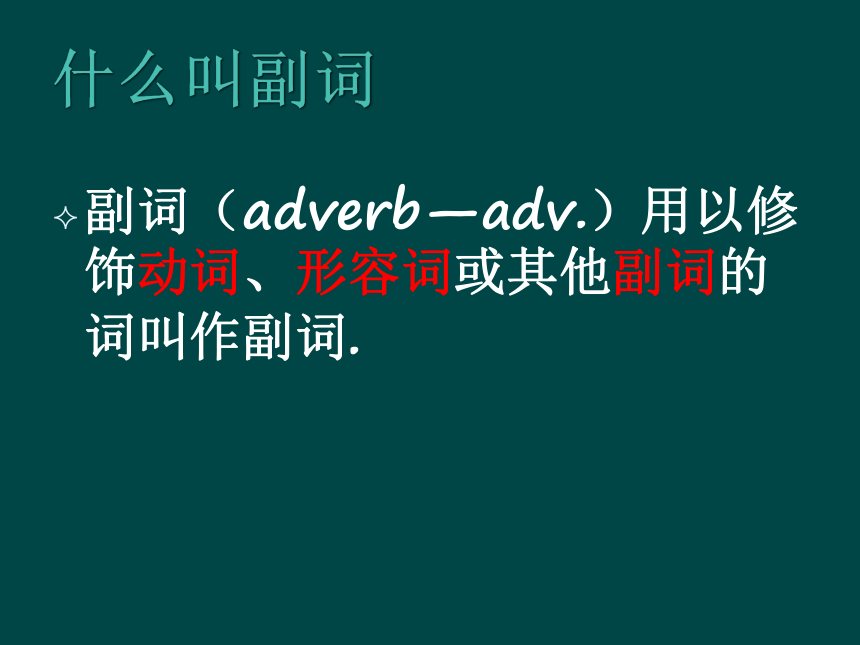
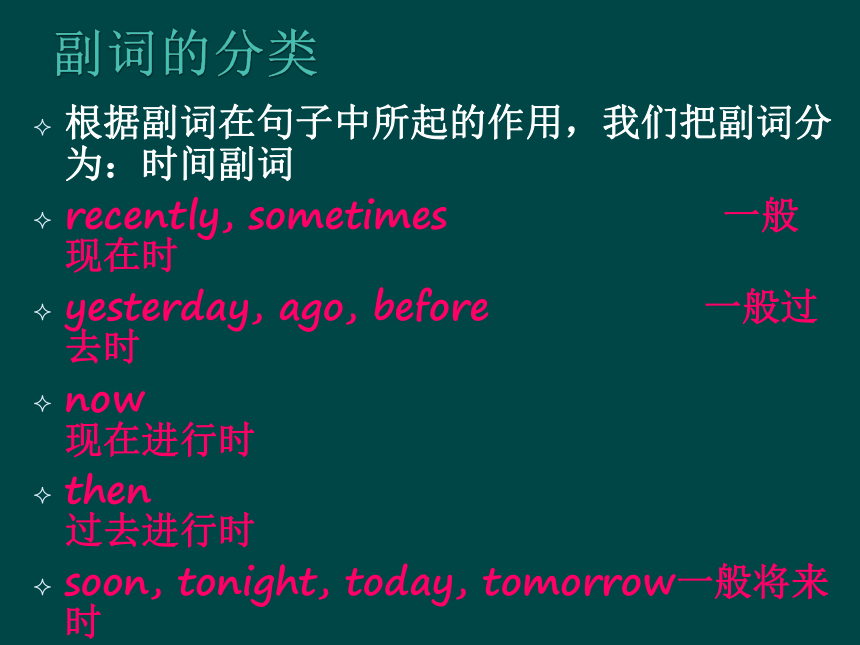
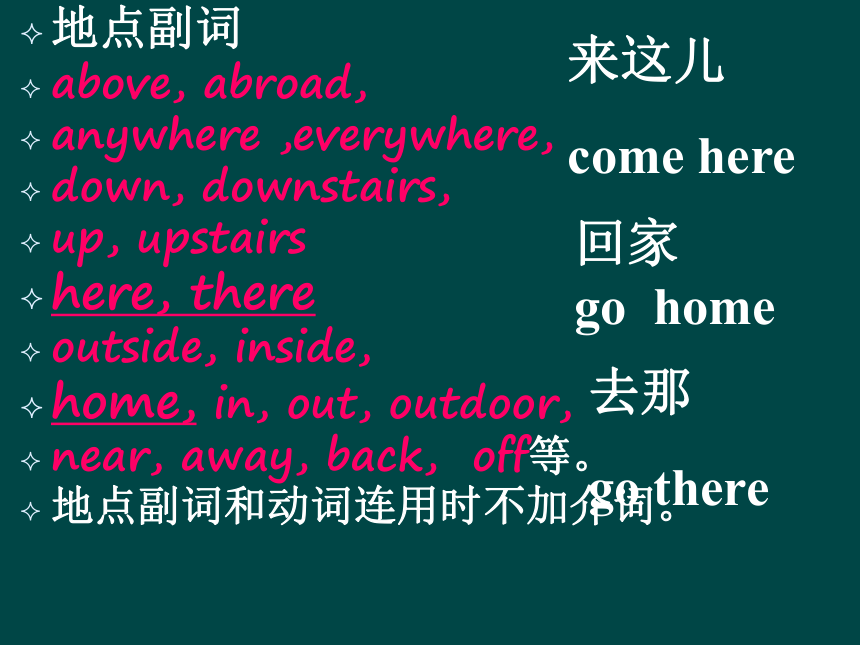

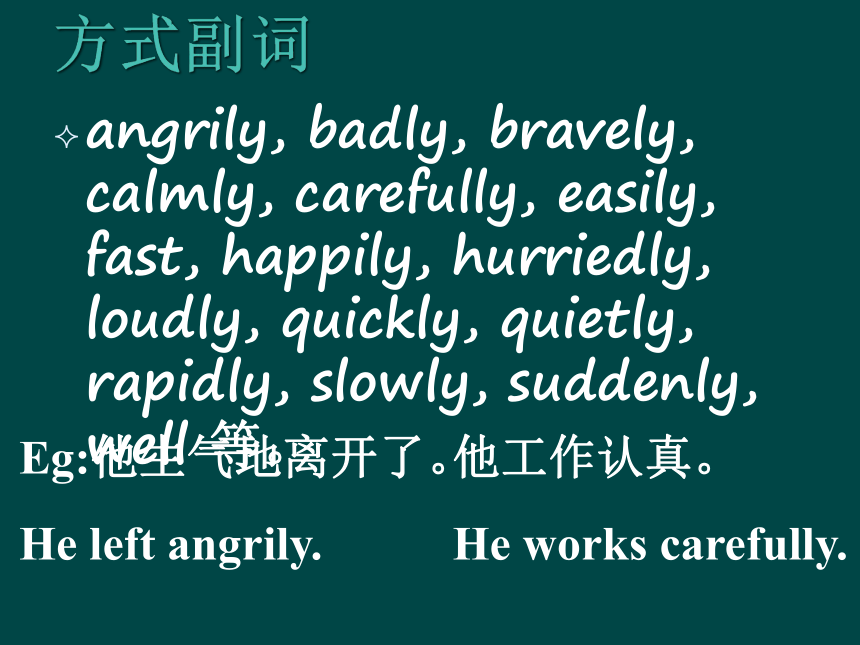
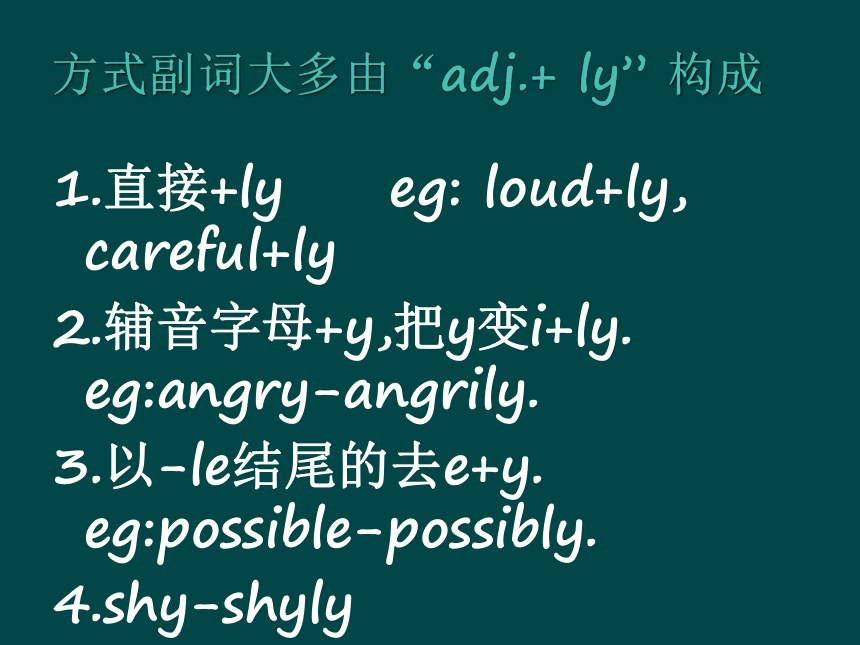
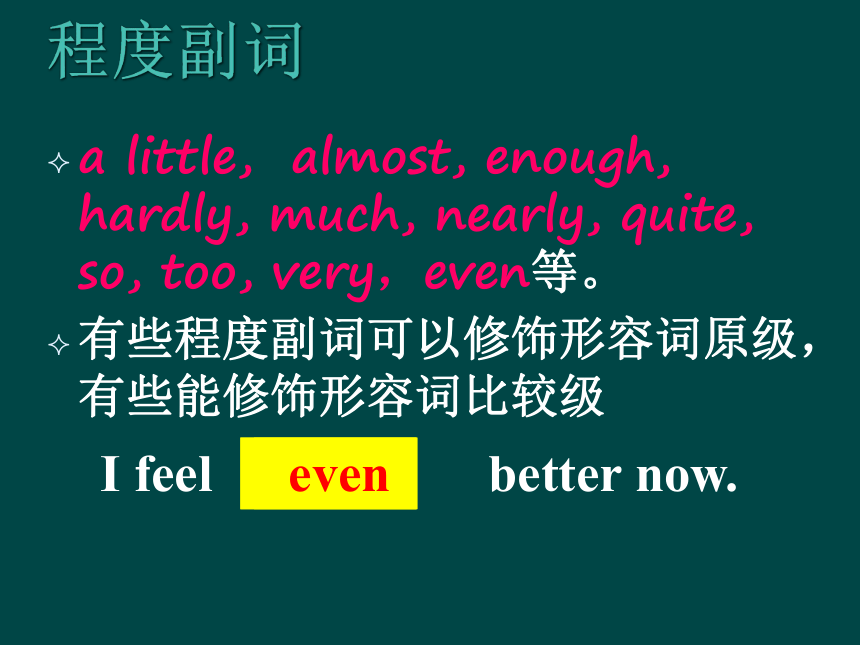

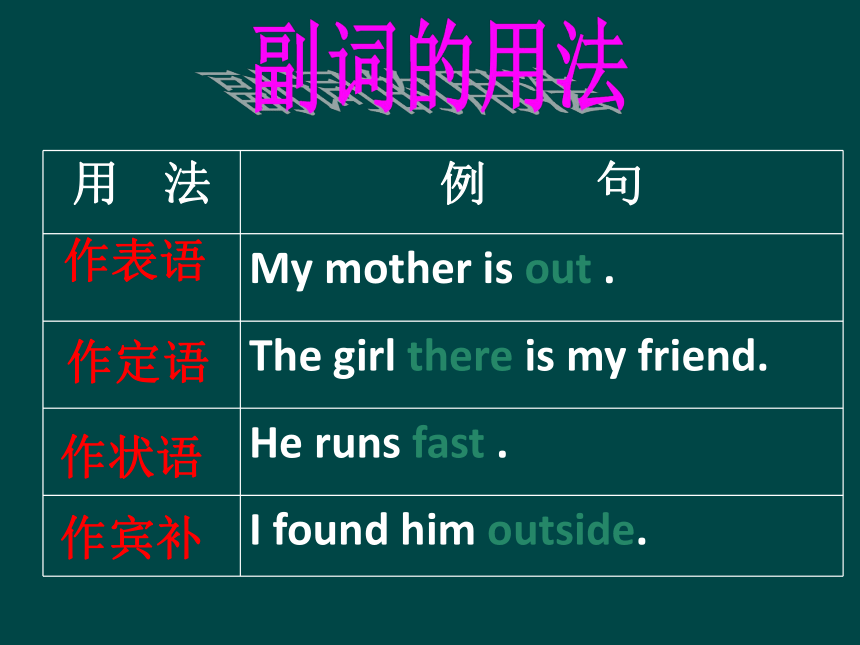
文档简介
(共32张PPT)
He runs quick .
ly
He smiles happy .
ily
She is beautiful.
very
I love you .
very much
副词(adverb—adv.)用以修饰动词、形容词或其他副词的词叫作副词.
根据副词在句子中所起的作用,我们把副词分为:时间副词
recently, sometimes 一般现在时
yesterday, ago, before 一般过去时
now 现在进行时
then 过去进行时
soon, tonight, today, tomorrow一般将来时
already,yet,ever,never等 现在完成时
时间副词是确定句子时态的重要标志,所以一定要牢固掌握不同时态的时间标志
地点副词
above, abroad,
anywhere ,everywhere,
down, downstairs,
up, upstairs
here, there
outside, inside,
home, in, out, outdoor,
near, away, back, off等。
地点副词和动词连用时不加介词。
回家
go home
来这儿
come here
去那
go there
always>usually>often>sometimes>seldom>never;
once,twice等。
angrily, badly, bravely, calmly, carefully, easily, fast, happily, hurriedly, loudly, quickly, quietly, rapidly, slowly, suddenly, well 等。
Eg:他生气地离开了。
He left angrily.
他工作认真。
He works carefully.
1.直接+ly eg: loud+ly, careful+ly
2.辅音字母+y,把y变i+ly. eg:angry-angrily.
3.以-le结尾的去e+y. eg:possible-possibly.
4.shy-shyly
a little, almost, enough, hardly, much, nearly, quite, so, too, very,even等。
有些程度副词可以修饰形容词原级,有些能修饰形容词比较级
I feel better now.
much
a little
even
when, where, why, how, how long, how soon, how often, how far 等
疑问副词常用来构成特殊疑问句。
用 法 例 句
My mother is out .
The girl there is my friend.
He runs fast .
I found him outside.
作表语
作定语
作状语
作宾补
I’ll go outside.
Please do it quickly.
I will go swimming tomorrow.
时间、地点和方式副词一般放在句末。
Tomorrow I will go swimming .
Dow flew the bat.
注意:有时为了强调时间、地点,也可把时间、地点副词放在句首。
He often goes to school.
行为动词之前
She is always kind to me.
You must always do your exercises.
在系动词、助动词和情态动词之后
Sometimes she comes late.
频度副词有时可以放在句首
1.修饰动词时,与频度副词一样
行为动词之前,在系动词、助动词和情态动词之后
2.修饰adj. adv.时放在所修饰的词前面
eg:You are a very good doctor .
注意:只有enough除外,放在所修饰的adj. adv.后面
他跑的足够的快。
He runs fast enough.
如句末同时有两类或更多的副词时,排列顺序为:
Eg:He ran very quickly in our school
程度 方式 地点
last year.
时间
程度+方式+地点+时间
1.直接+er/est.
2.辅音字母+y结尾的,把y变i+er/est.
3.由形容词+ly构成的副词,在前面加 more,most.
Eg: more carefully
原级
well
badly
much
little
far
late 比较级 最高级
better
best
later(较迟)
latest(最近的)
farther/further
farthest /furthest
less
least
most
more
worse
worst
Tom runs as fast as Mike.
as+adv.原形+as
否定 not as+副词原形+as “和… 不一样”
或 not so+副词原形+as“不及/不如…
Tom doesn’t run as fast as Mike.
1.行为动词+adv.比较级+than…
Tom比Mike跑的快。
Tom runs faster than Mike.
2.like A better than B
喜欢A,而不大喜欢B
我喜欢苹果,而不大喜欢香蕉。
I like apples better than bananas.
3.“Which /Who … like better,A or B ”
A和B,更喜欢...
4.Who +V.+adv.比较级,A or B
A和B谁更...
Lucy和Lily,你更喜欢谁
Who do you like better, Lucy or Lily
Tom和Mike谁跑的更快?
Who runs faster,Tom or Mike
1.“The+比较级…,the+比较级…”
越...就越...
2.“…比较级+and+比较级…”
越来...越...
越快越好。
The faster,the better.
他跑的越来越快。
He runs faster and faster.
1.主语+行为动词+(the)+adv.最高级+of (in)…
他们当中Tom跑的最快。
Tom runs fastest of them all.
Tom runs the fastest in our class.
2.Which/Who+行为动词+adv.最高级
“(在...中),哪个/谁最... ”
A、B和C,谁跑的最快?
Who runs the fastest,A、B or C
3.like A best of(in)…
“在...中,最喜欢A”
在所以书中,最喜欢这本。
I like this book best of all.
在图书馆中,我最喜欢这本。
I like this book best in the library.
“…than any other+可数名词单数”用比较级的形式表示最高级的意义。
Tom runs the fastest in our class.
TOM是我们班跑的最快的。
Tom runs faster than any other student in our class.
I love you .
I love you.
I love you .
I don’t love you .
too
also
as well
,either
as well, too, either, also
1.I feel better now.
2.She is beautiful.
3.I love you .
much
very
very much
Much too “非常”
Too much “太多”修饰不可数名词
1.This skirt is __________dear.
2.Don’t eat ____________ice cream.
much too
too much
思考:too many 修饰 什么词?
时间
现在
过去某时间
before
ago
Ago:一般过去时
Before:一般过去时,过去完成时,现在完成时
Thank you
for
listening!
He runs quick .
ly
He smiles happy .
ily
She is beautiful.
very
I love you .
very much
副词(adverb—adv.)用以修饰动词、形容词或其他副词的词叫作副词.
根据副词在句子中所起的作用,我们把副词分为:时间副词
recently, sometimes 一般现在时
yesterday, ago, before 一般过去时
now 现在进行时
then 过去进行时
soon, tonight, today, tomorrow一般将来时
already,yet,ever,never等 现在完成时
时间副词是确定句子时态的重要标志,所以一定要牢固掌握不同时态的时间标志
地点副词
above, abroad,
anywhere ,everywhere,
down, downstairs,
up, upstairs
here, there
outside, inside,
home, in, out, outdoor,
near, away, back, off等。
地点副词和动词连用时不加介词。
回家
go home
来这儿
come here
去那
go there
always>usually>often>sometimes>seldom>never;
once,twice等。
angrily, badly, bravely, calmly, carefully, easily, fast, happily, hurriedly, loudly, quickly, quietly, rapidly, slowly, suddenly, well 等。
Eg:他生气地离开了。
He left angrily.
他工作认真。
He works carefully.
1.直接+ly eg: loud+ly, careful+ly
2.辅音字母+y,把y变i+ly. eg:angry-angrily.
3.以-le结尾的去e+y. eg:possible-possibly.
4.shy-shyly
a little, almost, enough, hardly, much, nearly, quite, so, too, very,even等。
有些程度副词可以修饰形容词原级,有些能修饰形容词比较级
I feel better now.
much
a little
even
when, where, why, how, how long, how soon, how often, how far 等
疑问副词常用来构成特殊疑问句。
用 法 例 句
My mother is out .
The girl there is my friend.
He runs fast .
I found him outside.
作表语
作定语
作状语
作宾补
I’ll go outside.
Please do it quickly.
I will go swimming tomorrow.
时间、地点和方式副词一般放在句末。
Tomorrow I will go swimming .
Dow flew the bat.
注意:有时为了强调时间、地点,也可把时间、地点副词放在句首。
He often goes to school.
行为动词之前
She is always kind to me.
You must always do your exercises.
在系动词、助动词和情态动词之后
Sometimes she comes late.
频度副词有时可以放在句首
1.修饰动词时,与频度副词一样
行为动词之前,在系动词、助动词和情态动词之后
2.修饰adj. adv.时放在所修饰的词前面
eg:You are a very good doctor .
注意:只有enough除外,放在所修饰的adj. adv.后面
他跑的足够的快。
He runs fast enough.
如句末同时有两类或更多的副词时,排列顺序为:
Eg:He ran very quickly in our school
程度 方式 地点
last year.
时间
程度+方式+地点+时间
1.直接+er/est.
2.辅音字母+y结尾的,把y变i+er/est.
3.由形容词+ly构成的副词,在前面加 more,most.
Eg: more carefully
原级
well
badly
much
little
far
late 比较级 最高级
better
best
later(较迟)
latest(最近的)
farther/further
farthest /furthest
less
least
most
more
worse
worst
Tom runs as fast as Mike.
as+adv.原形+as
否定 not as+副词原形+as “和… 不一样”
或 not so+副词原形+as“不及/不如…
Tom doesn’t run as fast as Mike.
1.行为动词+adv.比较级+than…
Tom比Mike跑的快。
Tom runs faster than Mike.
2.like A better than B
喜欢A,而不大喜欢B
我喜欢苹果,而不大喜欢香蕉。
I like apples better than bananas.
3.“Which /Who … like better,A or B ”
A和B,更喜欢...
4.Who +V.+adv.比较级,A or B
A和B谁更...
Lucy和Lily,你更喜欢谁
Who do you like better, Lucy or Lily
Tom和Mike谁跑的更快?
Who runs faster,Tom or Mike
1.“The+比较级…,the+比较级…”
越...就越...
2.“…比较级+and+比较级…”
越来...越...
越快越好。
The faster,the better.
他跑的越来越快。
He runs faster and faster.
1.主语+行为动词+(the)+adv.最高级+of (in)…
他们当中Tom跑的最快。
Tom runs fastest of them all.
Tom runs the fastest in our class.
2.Which/Who+行为动词+adv.最高级
“(在...中),哪个/谁最... ”
A、B和C,谁跑的最快?
Who runs the fastest,A、B or C
3.like A best of(in)…
“在...中,最喜欢A”
在所以书中,最喜欢这本。
I like this book best of all.
在图书馆中,我最喜欢这本。
I like this book best in the library.
“…than any other+可数名词单数”用比较级的形式表示最高级的意义。
Tom runs the fastest in our class.
TOM是我们班跑的最快的。
Tom runs faster than any other student in our class.
I love you .
I love you.
I love you .
I don’t love you .
too
also
as well
,either
as well, too, either, also
1.I feel better now.
2.She is beautiful.
3.I love you .
much
very
very much
Much too “非常”
Too much “太多”修饰不可数名词
1.This skirt is __________dear.
2.Don’t eat ____________ice cream.
much too
too much
思考:too many 修饰 什么词?
时间
现在
过去某时间
before
ago
Ago:一般过去时
Before:一般过去时,过去完成时,现在完成时
Thank you
for
listening!
同课章节目录
- 词法
- 名词
- 动词和动词短语
- 动词语态
- 动词时态
- 助动词和情态动词
- 非谓语动词
- 冠词
- 代词
- 数词和量词
- 形容词副词及其比较等级
- 介词和介词短语
- 连词和感叹词
- 构词法
- 相似、相近词比较
- 句法
- 陈述句
- 一般疑问句和否定疑问句
- 特殊疑问句及选择疑问句
- 反意疑问句
- 存在句(There be句型)
- 宾语从句
- 定语从句
- 状语从句
- 主谓一致问题
- 简单句
- 并列句
- 复合句
- 主谓一致
- 主、表语从句
- 名词性从句
- 直接引语和间接引语
- 虚拟语气
- 感叹句
- 强调句
- 倒装句
- 祈使句
- 句子的成分
- 句子的分类
- 题型专区
- 单项选择部分
- 易错题
- 完形填空
- 阅读理解
- 词汇练习
- 听说训练
- 句型转换
- 补全对话
- 短文改错
- 翻译
- 书面表达
- 任务型阅读
- 语法填空
- 其他资料
